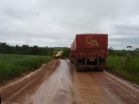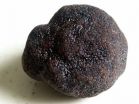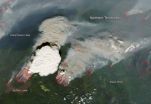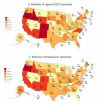(Press-News.org) URBANA, Ill. – With all the effort it takes to grow a food crop from seed to sale, it may be surprising that some farms in Brazil lose 10 to 12 percent of their yield at various points along the postharvest route. According to a University of Illinois agricultural economist, when it comes to meeting the needs of the world's growing population that's a lot of food falling through the cracks. Interestingly, farm managers who are aware of the factors that contribute to postharvest grain loss actually lose less grain. This was one of the findings in a study that examined how managers of large farms in the Brazilian state of Mato Grosso may be negatively affecting the efficiency of their own operations.
"Clearly there are things that you can do to reduce loss—you can put bed liners in trucks, you can adjust your combine, you can harvest more slowly—but for the farmers in Mato Grosso, it's not a high priority," said Peter Goldsmith. "It doesn't seem rational. If you see soybeans bouncing off your windshield from the truck ahead of you and bands of soybeans along the berm, why wouldn't you try to prevent it? It appears that farm managers in Brazil actually allow loss to happen because the cost of reducing loss is greater than the benefits."
Goldsmith said that one of the basic research questions of the ADM Institute for the Prevention of Postharvest Loss, which funded this study, is about why loss occurs. He said that although there are hundreds of articles about postharvest loss, no one is working with the farm managers to find out, from a managerial and organizational perspective, what drives this loss. There is a discrepancy between the reality of the postharvest loss and what the managers believe to be acceptable loss.
Goldsmith explained that in tropical systems where the farming season lasts much longer than in the United States the more intensive production results in two crops a year on the same plot of ground—soybeans followed by corn.
"Because they are in such a hurry to get the soybean crop harvested so they can get the maize crop planted before the rainy season, they may: harvest too fast, desiccate green soybean to advance harvest, or expose soybean to the weather during transport, all of which results in a 10 percent loss," Goldsmith said. "The loss isn't intentional but rather a level that the farm manager is willing to live with in order to get that second crop of corn."
A lack of understanding and awareness is also part of the problem. "When a farmer doesn't think that harvest speed is important, they have more loss. Likewise, if a farmer doesn't think that combine adjustments are important they'll have more loss. Those who realize that maintaining equipment is important, have less loss.
Consequently, technical training in the field with the equipment could be beneficial. But the cost of reducing loss further, using current technology, may exceed the benefits. Farmers may be unwilling to pay or invest in loss reduction."
In addition to harvest speed, the study identified several other factors contributing to grain loss: lack of truck regular maintenance; lack of adjustment to the combine at the platform; bad weather; bad road conditions; and a lack of employee training.
"What's interesting is that the results from the survey were so mixed," Goldsmith said. "Why wouldn't farmers have agreed 100 percent that harvest speed contributes to loss? Insects and rodents seemed to be unimportant. Truck conditions and bad weather were the top factors to blame for loss, but truck conditions were mentioned by only 62 percent. These causes should be common knowledge so I don't know why 100 percent of the responses didn't agree that, for example, poor road and truck conditions contribute to loss. The lack of definitiveness about this may indicate that loss is not a "front-of-mind" issue for managers, which, in turn, has significant implications for policy makers seeking to reduce post-harvest loss. Goldsmith believes that these tropical farmers have a variety of issues at hand that trump loss. "We may think of Brazil as sunshine and beautiful all the time, but farming is really tough in the tropics. There are pest pressures 24/7, soils are poor, there's an extreme rainy season, distance to markets is great, and road conditions are very rough. All sorts of factors make farming tough, but this area of the world has the greatest potential to materially augment global grain supplies."
For the study, an initial focus group of seven farmers was conducted to help frame the questions for an online survey. The survey respondents represent some of the largest farmers, not just in Mato Grosso, but in the world.
"This dominant class of medium- and large-tropical farm acreage operators who are producing most of the new grains are filling the gap between where we are now and where we need to be in 2050 to feed the world," Goldsmith said. "Sure, we can expand our crop among the developed countries of the world, but we're only helping at the margin. The potential for new grain producers on new land is coming from farmers in the Southern Hemisphere."
INFORMATION:
The study entitled "Managerial factors affecting post-harvest loss: the case of Mato Grosso Brazil" was co-authored by Anamaria Gaudencia Martins and Altair Moura and was published in a 2014 issue of the International Journal of Agricultural Management.
Farm manager plays leading role in postharvest loss
2014-08-06
ELSE PRESS RELEASES FROM THIS DATE:
NASA satellite paints a triple hurricane Pacific panorama
2014-08-06
In three passes over the Central and Eastern Pacific Ocean, NASA's Terra satellite took pictures of the three current tropical cyclones, painting a Pacific Tropical Panorama. Terra observed Hurricane Genevieve, Hurricane Iselle and Hurricane Julio in order from west to east. Iselle has now triggered a tropical storm watch in Hawaii.
The Moderate Resolution Imaging Spectroradiometer or MODIS instrument is a key instrument aboard NASA's Terra and Aqua satellites. Between the two satellites, MODIS instruments view the entire surface of the Earth every one to two days. When ...
Most kids with blunt torso trauma can skip the pelvic X-ray
2014-08-06
WASHINGTON – Pelvic x-rays ordered as a matter of course for children who have suffered blunt force trauma do not accurately identify all cases of pelvic fractures or dislocations and are usually unnecessary for patients for whom abdominal/pelvic CT scanning is otherwise planned. A study published online in Annals of Emergency Medicine last week casts doubt on a practice that has been recommended by the Advanced Trauma Life Support Program (ATLS), considered the gold standard for trauma patients "(Sensitivity of Plain Pelvis Radiography in Children with Blunt Torso Trauma). ...
Scientists discover how 'jumping genes' help black truffles adapt to their environment
2014-08-06
Black truffles, also known as Périgord truffles, grow in symbiosis with the roots of oak and hazelnut trees. In the world of haute cuisine, they are expensive and highly prized.
In the world of epigenetics, however, the fungi (Tuber melanosporum) are of major interest for another reason: their unique pattern of DNA methylation, a biochemical process that chemically modifies nucleic acids without changing their sequence. Epigenetics is the study of changes in gene expression caused by mechanisms other than changes in the DNA sequence.
A newly published study in the journal ...
Wiki ranking
2014-08-06
Wikipedia the free, online collaborative encyclopedia is an important source of information. However, while the team of volunteer editors endeavors to maintain high standards, there are occasionally problems with the veracity of content, deliberate vandalism and incomplete entries. Writing in the International Journal of Information Quality, computer scientists in China have devised a software algorithm that can automatically check a particular entry and rank it according to quality.
Jingyu Han and Kejia Chen of Nanjing University of Posts and Telecommunications, explain ...
A new way to model cancer
2014-08-06
CAMBRIDGE, MA -- Sequencing the genomes of tumor cells has revealed thousands of mutations associated with cancer. One way to discover the role of these mutations is to breed a strain of mice that carry the genetic flaw — but breeding such mice is an expensive, time-consuming process.
Now, MIT researchers have found an alternative: They have shown that a gene-editing system called CRISPR can introduce cancer-causing mutations into the livers of adult mice, enabling scientists to screen these mutations much more quickly.
In a study appearing in the August 6th issue of ...
Discovery yields master regulator of toxin production in staph infections
2014-08-06
St. Jude Children's Research Hospital scientists have discovered an enzyme that regulates production of the toxins that contribute to potentially life-threatening Staphylococcus aureus infections. The study recently appeared in the scientific journal the Proceedings of the National Academy of Sciences (PNAS).
Researchers also showed that the same enzyme allows Staphylococcus aureus to use fatty acids acquired from the infected individual to make the membrane that bacteria need to grow and flourish. The results provide a promising focus for efforts to develop a much-needed ...
Pyrocumulonibus cloud rises up from Canadian wildfires
2014-08-06
The Northern Territories in Canada is experiencing one of its worst fire seasons in history. As of this date, there have been 344 wildfires that have burned 2,830,907 hectares of land (close to 7 million acres). The area around the Great Slave Lake, Yellowknife, Ft. Smith, and the Buffalo Lake have been plagued with uncontrolled fires all season long. This natural-color image collected by the Moderate Resolution Imaging Spectroradiometer (MODIS) aboard the Aqua satellite on August 05, 2014 shows a pyrocumulonimbus cloud erupting from the fire north of Buffalo Lake. It ...
A website to help safeguard the United States borders against alien scale insect pests
2014-08-06
Scales are small insects that feed by sucking plant juices. They can attack nearly any plant and cause serious damage to many agricultural and ornamental plants. While native scales have natural enemies that generally keep their populations in check, invasive species often do not, and for this reason many commercially important scale pests in the United States are species that were accidentally introduced.
In order to facilitate the identification of alien species at U.S. ports-of-entry, scientists of the United States Department of Agriculture and California Department ...
Discovery about wound healing key to understanding cell movement
2014-08-06
Research by a civil engineer from the University of Waterloo is helping shed light on the way wounds heal and may someday have implications for understanding how cancer spreads, as well as why certain birth defects occur.
Professor Wayne Brodland is developing computational models for studying the mechanical interactions between cells. In this project, he worked with a team of international researchers who found that the way wounds knit together is more complex than we thought. The results were published this week in the journal, Nature Physics.
"When people think ...
Geography matters: Model predicts how local 'shocks' influence U.S. economy
2014-08-06
PRINCETON, N.J. -- A sudden closing of a major airline hub such as the main Atlanta airport would undoubtedly leave thousands of travelers stranded. Because of Atlanta's hub status, such a blow would be felt nationally, altering the travel plans of millions while impacting the travel industry, tourism and other segments of the economy.
A team of economists including Esteban Rossi-Hansberg of Princeton University's Woodrow Wilson School of Public and International Affairs have developed a model that can measure the widespread effects of local industry fluctuations such ...






